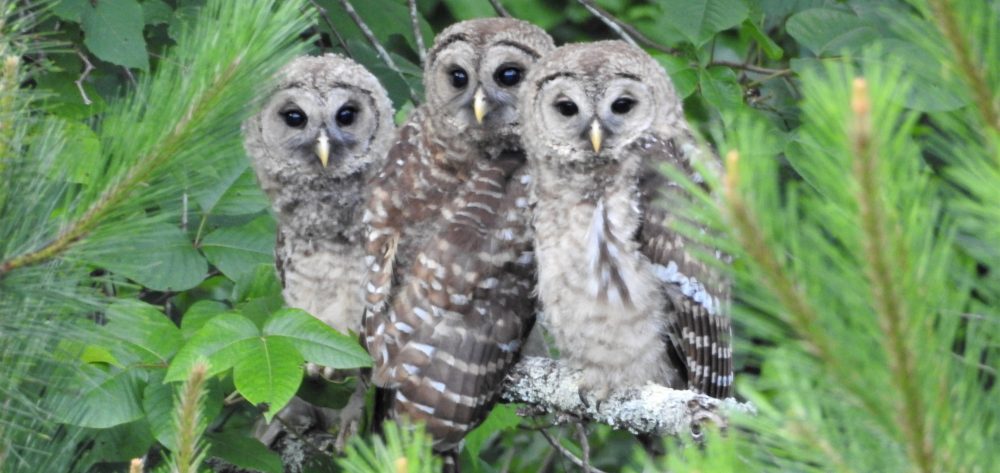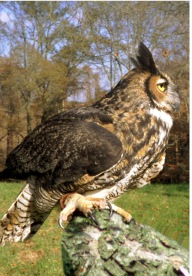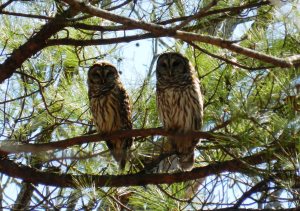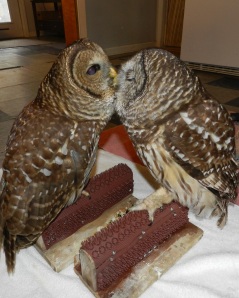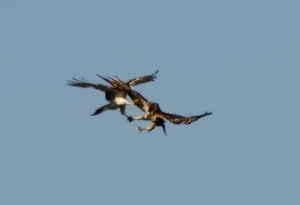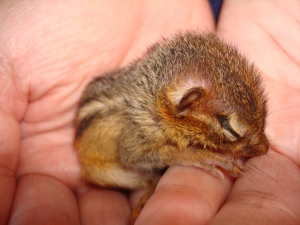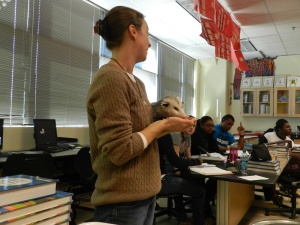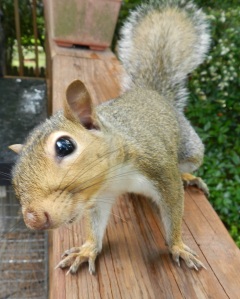Winter is a great time for viewing wildlife. Even in the cold, gray, wet weather that makes many of us cringe and stay indoors, much of the animal world stays active, and the absence of leaves on the trees makes wildlife easier to spot, especially birds. Some animals aren’t hindered by winter’s chill at all, instead finding it the perfect climate to “turn up the heat.” Believe it or not, winter is the best time of the year to observe several species of raptors that begin courtship and breeding even during the coldest and darkest months.
The Great Horned Owl is one of the earliest breeders in North America, beginning courtship calls as early as October and choosing a mate by December. The male attracts the female’s attention by puffing up his white throat and hooting while bowing to her. If the female is sufficiently impressed, she joins in the bowing and hooting, and the birds may remain mates for their entire lives. Breeding typically occurs in January or February with females laying one to four eggs that hatch in about seven weeks. Now is the best time of year to get out and look for these birds, particularly while the bare tree branches make it easier to spot their nests, which are often taken over from hawks, crows, or squirrels. In fact, here in Georgia these owls have already been spotted on their nests, used only when the females are brooding eggs and tending to their young. Be sure to look for the two ear tufts popping out from the top.
Great Horned Owls are not the only owls getting “busy” this season. Barred Owls also begin reuniting with their mates and refurbishing or scouting for nest sites in the cold months of winter. I’ve been hearing the local pair of Barred Owls hooting it up in my neighborhood for the past month, and I have been fortunate to see them roosting together in our neighborhood park the past two winters. I will be keeping my eyes peeled again this season! At AWARE wildlife center where I volunteer, our pair of nonreleasable Barred Owls, Gazer and Tappy, have become increasingly vocal. As is typical in the wild, Tappy offers food to Gazer, and they are frequently seen preening each other. Gazer must be impressed with Tappy’s attention–she laid her very first egg in late fall (though did not incubate it)!
Bald eagles are also early breeders, typically building their nests and laying eggs by mid-February, even earlier in southern states. (During a recent trip to Florida, I saw two bald eagles on their nests on New Year’s Eve!) Eagle’s nests, usually made of sticks and other plant material and found in big trees near large bodies of water, are the largest nests of any bird in North America. These enormous structures can measure over nine feet in diameter and twenty feet in height and can weigh more than two tons! A pair of eagles will typically use the same nest for many successive years. Eagles have a spectacular courtship ritual involving vocalizations and acrobatic flights that sometimes include a spiraling freefall from great heights with interlocked talons. What a thrill it would be to see this amorous display!
Red-tailed hawks are also getting ready to breed at this time of year by building or refurbishing their nests of twigs, foliage, and other plant matter. Eggs are typically laid in March or April, depending on latitude. Like eagles, Red-tailed Hawks have dramatic aerial courtship displays. The male and female soar in circles calling with their unmistakable shrill, raspy cries. The male dives steeply then rises again, repeating this display several times. The display sometimes culminates with the pair clasping talons and plummeting in a spiral toward the ground before pulling away. Because Red-tailed Hawks are possibly the most common hawks in North America and are well-adapted to living in proximity to humans, careful observers are sure to be rewarded with sightings of these beautiful birds.
Witnessing these powerful birds is a reminder of what an incredibly diverse and magical planet we share. For those inclined to stay indoors in the winter months, several websites with live “nest cams” offer viewers the unique opportunity to watch these birds building nests, brooding eggs, and raising young in real time (see below for links), but how much more fascinating it is to witness it in person! So, before the leaves obscure the treetops, bundle up, grab a pair of binoculars, and keep your ears open and eyes toward the skies!
Recommended Nest Cams:
Watch Georgia’s beloved Berry College Eagles raise their young for the third year in a row. Mom is already incubating two eggs! Or check out the Atlanta Falcons (Peregrine, that is!).
The Cornell Lab of Ornithology is a trove of all sorts of information about birds and has nestcams for several species of birds. Tune in to this year’s livestream cameras here.
